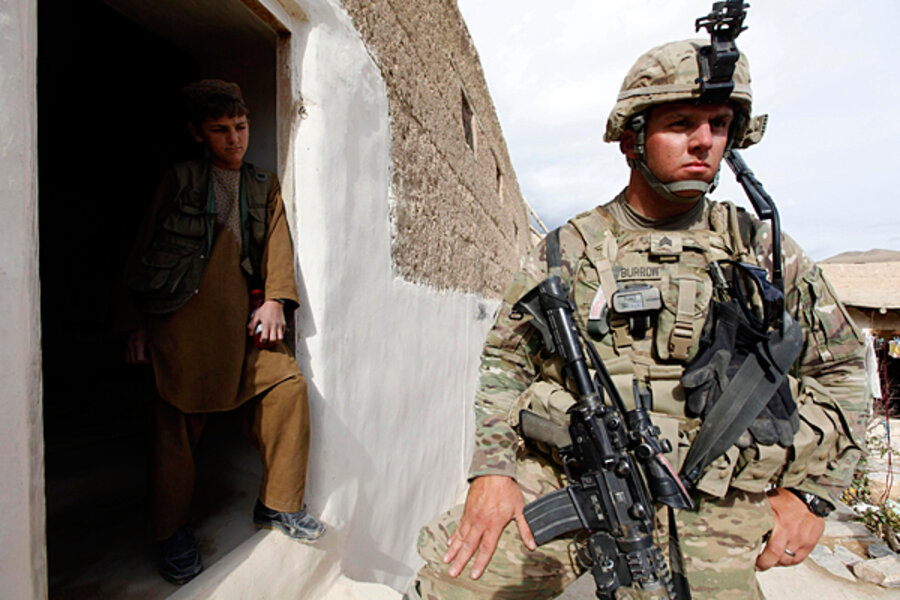Afghanistan after the US: What's next?
Loading...
| Maidan Shahr, Afghanistan
A major question at the NATO summit in Chicago this weekend: How will Afghanistan – and its government – fare after US troops leave?
The answer is likely to come from the Afghan countryside. About three-quarters of the population live in rural areas, far removed from the international talks and meetings about its future. Just how local governments tackle security and development, and adapt to impending financial shortages, could determine how Afghans see the value of a centralized government – and ultimately determine whether Afghanistan can attain stability and development.
In Wardak Province, just west of Kabul, the ubiquitous challenges that plague Afghanistan are playing out. But so too are successes. The province has seen progress under Gov. Mohammad Halim Fidai. “I’m very confident and hopeful that with investment in human capital, education, natural resources – like mines and agriculture – that will be a big step to bring more investment and help so Afghanistan can stand on its own two feet and not have to ask for a penny from any other country,” he says.
Like most issues in Afghanistan, there is no way to definitely demonstrate whether a region like Wardak is moving forward or backward. But Governor Fidai’s daily schedule serves a reminder of progress.
In the course of two days recently, he cut two ceremonial ribbons to inaugurate a public park and youth center and scoped the first shovel of dirt at the ground breaking of a water-shed management project.
After less than four years as governor, he’s seen Afghan security forces in his province grow from just 900 to 3,900. He estimates that he’s overseen more than $1 billion in development spending and he’s found ways to steadily increase tax revenues. His province also saw a 25 percent reduction of insurgent attacks last year.
Challenges and criticism
Still, the challenges are not few. At the recent ground breaking for a US-funded, half-million dollar watershed management project, locals didn’t appear to understand what all the work is for.
Ground water levels have been dropping throughout the area, a serious concern for farmers. The watershed project is designed to raise water levels by constructing a central reservoir that will replenish wells throughout the area. Several tribal elders, at the ceremony, however, appeared to think the reservoir was a new place for them to come fill buckets, an action that would render the project futile.
This disconnect is common throughout Afghanistan, says Yama Torabi, executive director of Integrity Watch Afghanistan. Those responsible for projects often fail to communicate to local community members the purpose of a given project or even that it’s happening.
“You have to take into consideration [the community’s] needs, and usually this is not the case,” says Mr. Torabi.
In a community-monitoring effort of 240 development projects in six provinces, which did not include Wardak, IWA found major problems, such as shoddy construction practices, that required attention at two-thirds of the projects. Torabi says in areas like Wardak, where security is a serious concern, there are likely to be even more problems.
Presently, almost all provincial development in Afghanistan comes from foreign funding. Although the development effort in Afghanistan has often faced criticism for problems like those described by Torabi, it’s helped provide services that legitimize the government for many Afghans.
But as the US and NATO reduce their commitment here, that gain, too, is in jeopardy. Already, President Obama has proposed a 34 percent cut on Afghan reconstruction spending in fiscal year 2013.
In Wardak, tax revenues amount to about a quarter of a million dollars. Though that has exceeded Fidai's government’s goals, it’s still only enough to fund half of one minor development effort like the watershed management project. Fidai says he hopes to continue improving tax collection efforts in Wardak to make up for the coming reductions in aid.
On the issue of security
A number of locals criticize Afghan and international security forces for focusing their efforts along the Kabul-Kandahar highway that passes through the province.
They concede that the road is much safer now, but they say villages not on the main road often still face harassment and intimidation. Sher Wali Wardak, a member of parliament who represents the province, says it’s become too dangerous to visit remote villages in the province.
“In Wardak, everything is going in reverse. It’s going to the negative side, not the positive side. If you can just compare it with 2006 or 2007, the security belt is becoming narrower and narrower,” says Mr. Wardak.
Undaunted
Fidai is aware of all the challenges, but he remains undaunted.
He took the highest seat of government in Wardak in July 2008 when the situation he inherited couldn’t seem more dire. Security officials in the area advised him not to travel more than a half a mile away from his offices in the province capital of Maidan Shahr. Government revenues were just a quarter of their annual targets and Wardak, along with the rest of the country, was well into a resurgence of the Taliban.
Fidai, who holds a masters degree in public relations and speaks near-native English, approached his new post largely as a management challenge. He brought in a staff he trusted and worked to retain them by offering competitive salaries with money he saved with simple measures, such as using local building materials on government buildings instead of more expensive imported construction supplies.
“Whether I am successful or not, we’ll leave it for the people to decide,” he says.





